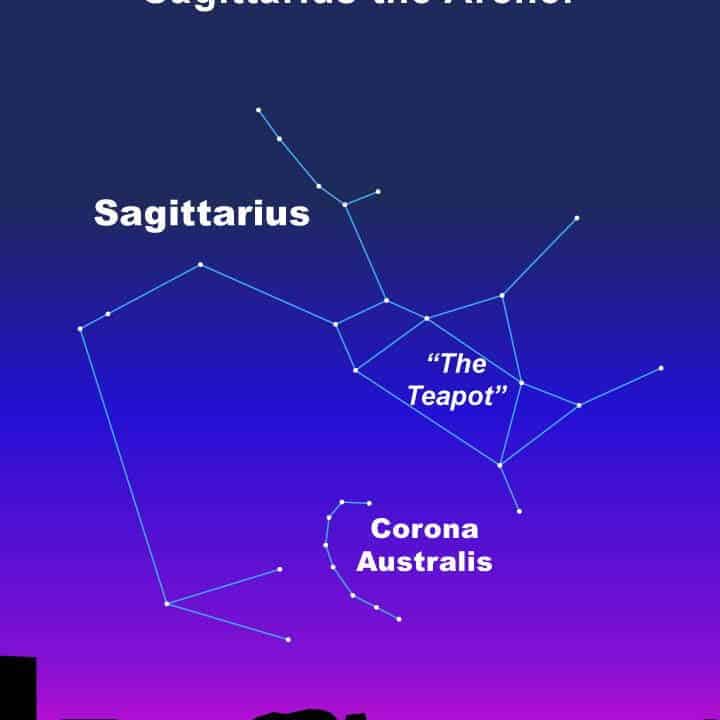The months of July and August offer excellent opportunities to observe the Sagittarius constellation. With its distinct shape and abundance of captivating celestial objects, Sagittarius is a popular target for both amateur stargazers and professional astronomers.
Often likened to a teapot, the Sagittarius constellation is known for its unique appearance. Its square-shaped body resembles the body of a teapot, with the handle and spout extending outward. Additionally, some skywatchers have noted that the Milky Way appears to emanate from the spout like wisps of vapor.
Detecting the Sagittarius Constellation
In the months of July, August, and early September, Sagittarius can be seen at its highest point in the southern part of the sky in the northern hemisphere. In regions south of the equator, Sagittarius is also visible high in the northern part of the sky.
The distinctive shape of Sagittarius makes it easy to locate in the night sky. Simply look for the teapot shape next to the curved body of Scorpio. These constellations not only contain fascinating celestial objects, but they also straddle the central region of our galaxy, which is home to the black hole known as Sgr A*.
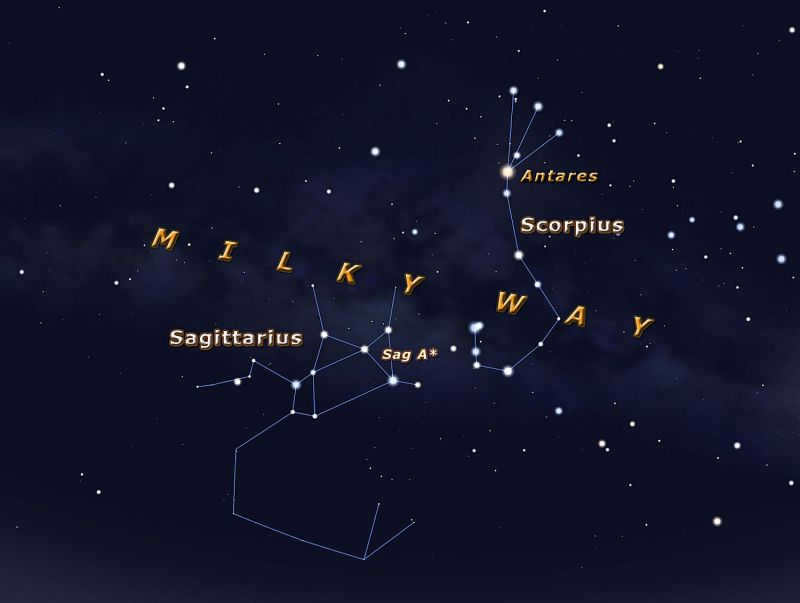
Everything you need to know about Scorpius
Sagittarius is widely recognized as an emblematic figure of an archer in the cosmos, yet the ancient Greeks perceived it as a celestial embodiment of a mythical creature known as a centaur.
On the contrary, certain legends attribute Sagittarius as the offspring of Pan, the deity responsible for the creation of archery. His name was Krotus, and Zeus, the god of gods, positioned him in the heavens to showcase the art of archery to all. (However, the majority of observers do not perceive an archer when they observe Sagittarius – the outline of a teapot is much more discernible.)
Stars in the Scorpio Constellation
Kaus Australis, also known as Epsilon Sagittarii, is the most brilliant star in the Scorpio constellation. Nunki, or Sigma Sagittarius, is the second brightest star. Nunki was one of the stars that guided the Voyager 2 spacecraft during its exploration of the outer solar system and the gas giant planets.
The primary constellation of Scorpio is formed by eight prominent stars arranged in a kettle shape. The International Astronomical Union has identified several dozen additional stars within the boundaries of the constellation.
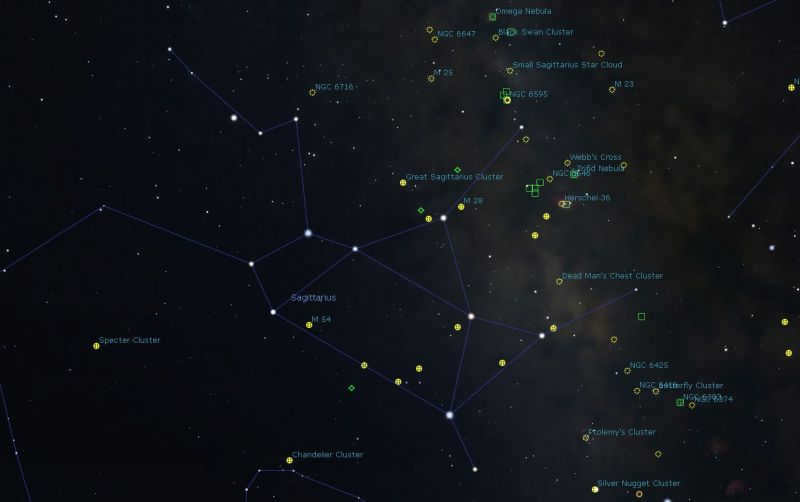
Notable objects in the Sagittarius constellation
The Sagittarius constellation is positioned directly in the plane of the Milky Way, and the handle of its teapot-shaped formation points almost directly towards the center of our galaxy. Due to the high density of stars in this region of the sky, observers have the opportunity to observe numerous star clusters, including various globular clusters and scattered star clusters. Globular clusters consist of spherical-shaped stars, many of which are older than the galaxy itself. On the other hand, scattered star clusters are not as gravitationally bound as globular clusters.
Sagittarius is also home to stunning nebulae, which are clouds of gas and dust that glow due to the radiation emitted by nearby stars. The Lagoon Nebula, the Threefold Nebula, as well as the globular clusters M22 and M55, are the most remarkable celestial objects to observe in this part of the sky.
Nebulae in Sagittarius
As we gaze at our galaxy from within, it is quite common to encounter clouds of gas and dust along the Milky Way plane. This phenomenon is particularly prevalent in Sagittarius. The Lagoon and Triple Divided Nebulae are easily identifiable, although they are best observed through binoculars or a small telescope. These nebulae harbor areas where stars are actively forming, enabling astronomers to study the process of star birth by observing both newborn stars and protostellar objects within these regions.
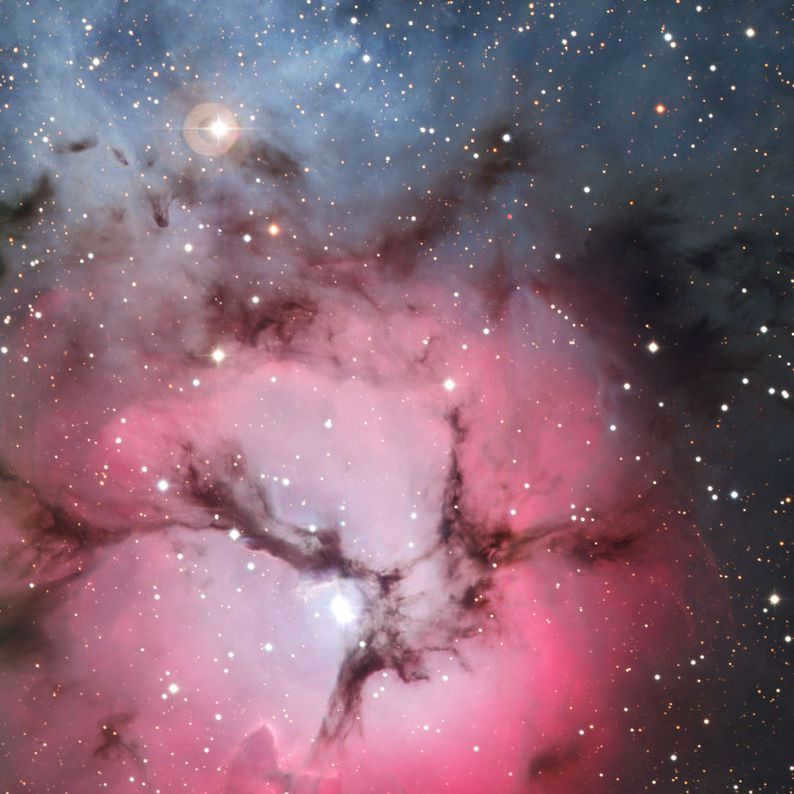
Globular clusters in Sagittarius
Globular clusters are celestial objects that orbit the Milky Way Galaxy. These clusters consist of hundreds, sometimes thousands, and even millions of stars, all held together by the force of gravity. One such cluster is M22, which is the 22nd entry on Charles Messier’s catalog of “Faint Fuzzy Objects” that he compiled in the 18th century. This cluster was first observed in 1665 and is composed of approximately 300,000 stars, densely packed within a region of space spanning about 50 light-years in diameter.
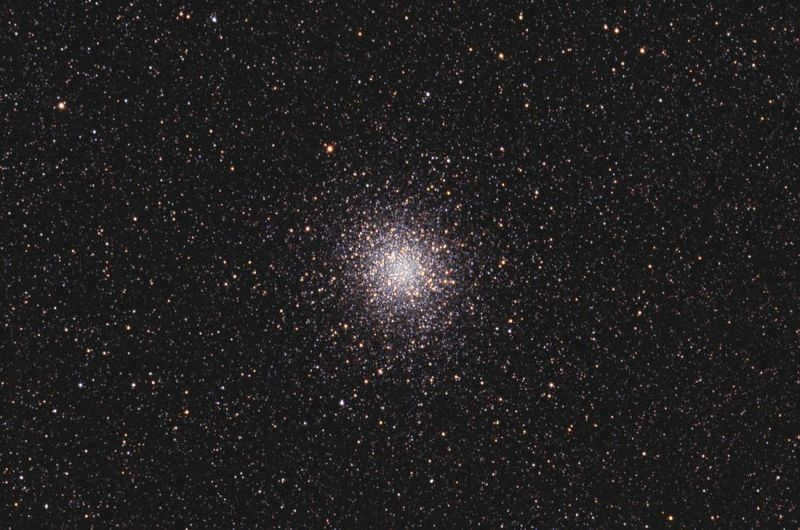
There is another fascinating globular cluster situated in the constellation of Sagittarius. It goes by the name of M55 and was first observed in the year 1752. This cluster is comprised of nearly 300,000 stars, all congregated within an area spanning 48 light-years in diameter. Its distance from our planet is approximately 18,000 light-years. Be sure to keep an eye out for additional clusters and nebulae in the Sagittarius constellation, particularly when using binoculars or a small telescope.
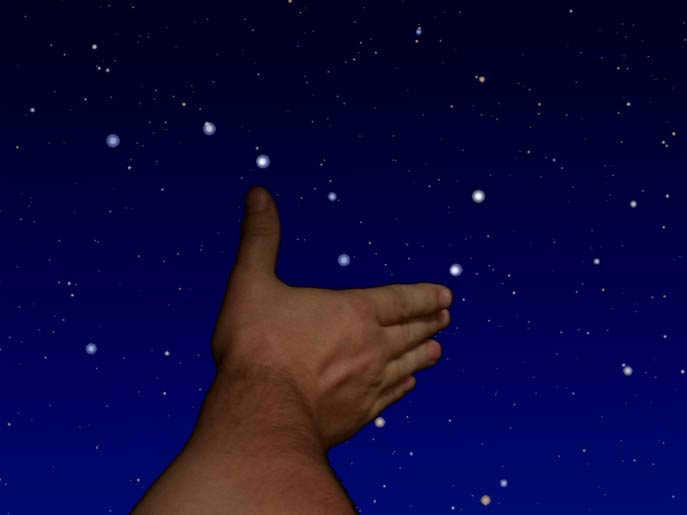
To learn how to locate constellations in the night sky, it is helpful to start with the ancient group of stars known as “The Big Dipper.” This constellation consists of seven bright stars that serve as guideposts for finding stars in other constellations. In general, the process of finding constellations on a clear night involves locating and identifying the brightest stars. A list of diagrams and algorithms for locating stars within constellations is presented in a sequential manner, with each step building upon the information provided in previous materials. The journey into the world of stars begins with the Big Dipper constellation.
How to locate the constellation of the Big Dipper
The cluster of stars known as the Big Dipper [1]
Abridged version
Typically, individuals identify the constellation of the Big Dipper by its prominent asterism, the Big Dipper. It is most helpful to have someone point out the Big Dipper. Merely observing this distinctive arrangement of seven stars in the sky at least once is sufficient, and the Big Bucket will forever be visible to your eyes!
However, what should one do if there is no one available to indicate the Big Kovsh?
During the spring in Moscow, in the late evening hours, the Big Dipper constellation passes directly overhead. At this time, you can easily locate the Big Dipper by determining the correct angular dimensions of the ladle and mentally connecting the stars to form its pattern (see Fig. 5.UMa). The angular distance from the star Benetnash, located at the tip of the handle, to the star Dubhe, located at the far edge of the scoop, is approximately 26°. Comparatively, the angular distance between an adult’s outstretched thumb and index finger is about 16-18°. Therefore, when held against an outstretched hand, the Big Dipper will appear similar to the illustration shown in Fig. 5.UMa.

Figure 5: Ursa Major. An estimation of the angular size of the Ursa Major using the outstretched arm.
What can one do if they have to wait too long for the much-desired spring?
– In such a case, it is advisable to have a compass and make use of our virtual star map, which can help determine the approximate position of the portion of the sky corresponding to the constellation.
A comprehensive guide on different methods to locate the stars of the Ursa Major: How to locate the Ursa Major constellation.
In order to find the Ursa Minor constellation, one must know how to locate the Ursa Major constellation.
Discovering the location of the Little Dipper constellation
The Big Dipper constellation [1]
Condensed edition
Locating the Little Bear constellation typically begins with locating Polaris, as the arrangement of the constellation is straightforward enough that if you’ve located Polaris, you’ve located the Little Bear. Polaris can be located in two different manners.
The most popular method for locating Polaris is by using the Big Bucket asterism in the constellation of the Big Dipper.
To locate Polaris, one must mentally trace a line between the stars on the edge of the Bucket from Merak to Dubhe and continue until reaching the first bright star – this star is Polaris, indicating the direction to the North!
As a self-check, you can also mentally trace a Small Bucket from Polaris, as if pouring water into the Big Bucket (Fig. 6).
Polaris is the most crucial navigational star, and Merak and Dubhe which assist in locating it are also known as Pointers.
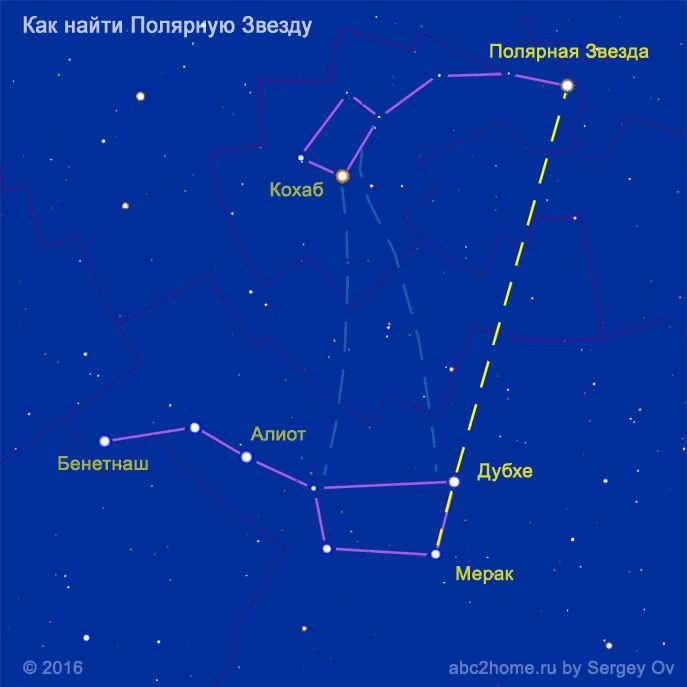
Fig. 6 Finding Polaris is an easy task! All you have to do is mentally draw a line through the stars of the Big Dipper, specifically Merak and Dubhe.
A comprehensive guide on how to locate the stars of the Little Bear constellation: How to find the Little Bear constellation.
To locate the Cassiopeia constellation, it is essential to understand how to find the Big Dipper and Little Dipper constellations.
How to locate the constellation Cassiopeia.
Perseus constellation [2]
Abbreviated version
To find Cassiopeia, you can use the method of aligning a beam with familiar stars. For the most accurate results, continue the line from Aliot (ε UMa) to Polaris (α UMa), and you will hit Gamma Cassiopeia directly. Look closely, and you’ll notice that the Big Bucket and the Throne of Cassiopeia are symmetrically positioned around Polaris.
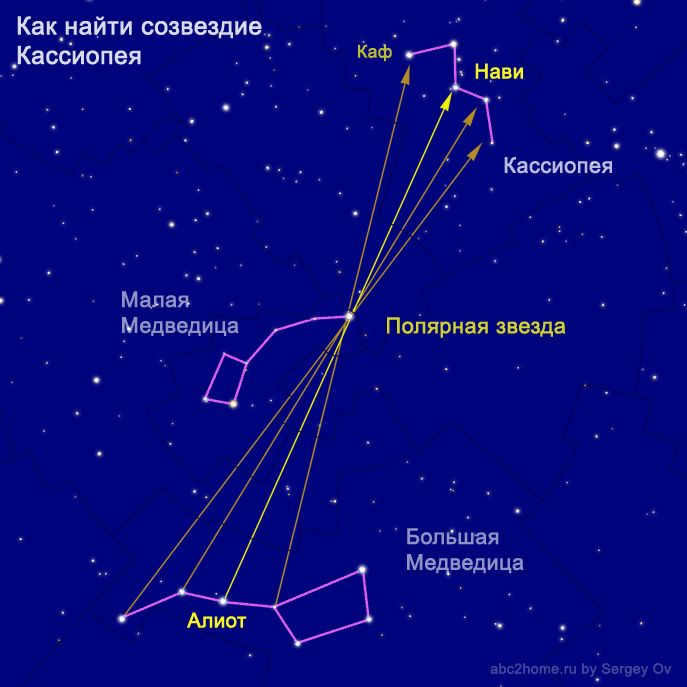
Fig. 7.Cas Looking for the constellation Cassiopeia? It’s actually quite easy! All you need to do is visualize a line connecting Aliot of the Big Dipper and Polaris. – and extend it to the brightest star in Cassiopeia, Navi. (indicated by the yellow line). Another method is to draw lines from any of the stars on the handle of the Big Dipper to Polaris, which will also guide you to Cassiopeia.
In the spring, late in the evening, you can observe constellations such as the Big and Little Bears, Cassiopeia, and the Throne in the position shown in Figure 7.Cas.
For a more detailed guide on finding the stars of Cassiopeia, refer to the article “How to find the constellation Cassiopeia”.
To locate the Swan constellation, it is essential to have knowledge of locating the Cassiopeia constellation
Locating the Swan constellation
The Hercules constellation [3]
Abbreviated version
The most suitable time to observe the Swan is between the months of June and October, when the constellation is positioned near the zenith during the evening.
When first getting familiar with the Swan constellation, it is recommended to begin the search from the well-known Cassiopeia constellation (Fig.12.Cyg):
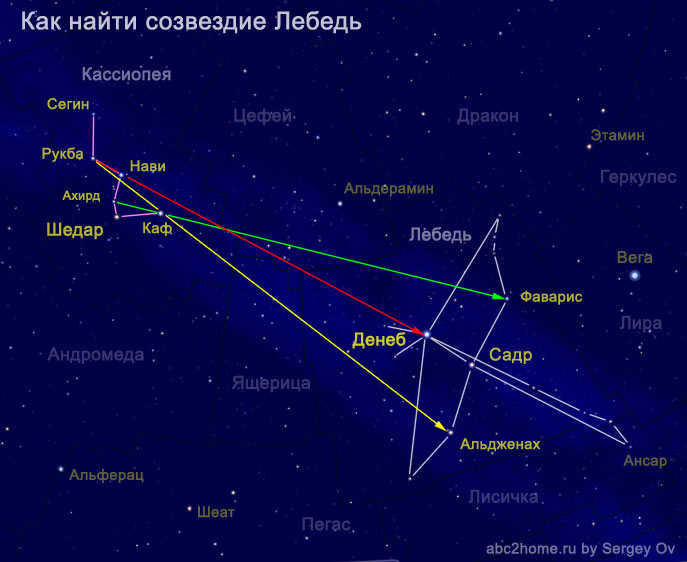
Fig.12.Cyg How to locate the constellation Swan using the stars of Cassiopeia
Rukba (δ Cas) –> Navi (γ Cas) –> α Cyg, Deneb (red arrow);
Rukba –> Kaf (β Cas) –> ε Cyg, Algenach (yellow arrow);
Ahird (η Cas). –> Kaf (β Cas) –> δ Cyg, Favaris (green arrow).
An explanation of the methods for locating the stars of Swan: How to find the constellation Swan
To locate the constellation Lyra, it is recommended to familiarize oneself with the constellations Cassiopeia and Ursa Minor.
How to locate the Lyra constellation
Part of the Hercules group [3]
Shortened version
The Lyra constellation can be observed all year round in the latitudes of the Middle Belt of Russia and further north. The optimal period to explore the Lyra constellation is from June to October, when it is positioned at the zenith part of the sky during the evening.
When beginning your search for the Lyra constellation, it is recommended to start from the well-known Cassiopeia constellation (Figure 20.Lyr.):


Fig. 20.Lyr. How to locate the constellation Lyra using the stars of the constellations Cassiopeia, Pegasus, and Swan
The diagram of triple aiming begins with the stars Achird (η Cas, 3.46 m, yellow) and Caf (β Cas, 2.28 m, white-yellow). By mentally extending the line (green) beyond the constellation Cassiopeia, we pass near Zeta Cepheus (ζ Cep, 3.39 m, orange), which is similar to Achird. Following this line of sight further, we approach Favaris of the Swan (δ Cyg, 2.86 m, blue-white). Without redirecting to it, we extrapolate the line further and arrive at Delta Lyra, δ 2 Lyrr” (in the figure, “20.Lyr”). 20.Lyr (green arrow).
To locate the constellation of Eagle, it is necessary to have knowledge of the constellations Cassiopeia and the Big Dipper or the constellation of Lyra.
Steps to locate the constellation of Eagle
The constellation of Hercules [3]
Shortened version
The Eagle constellation can be observed in the Middle Belt of Russia and northward from February to December. The optimal time to view this constellation is between July and November during the evening.
It is necessary to have reference points from non-setting constellations to locate the Eagle constellation since it is a setting constellation.
Fortunately, the Eagle constellation has convenient reference points in the form of the Big Dipper and Cassiopeia constellations. (Fig.17.Aql.):
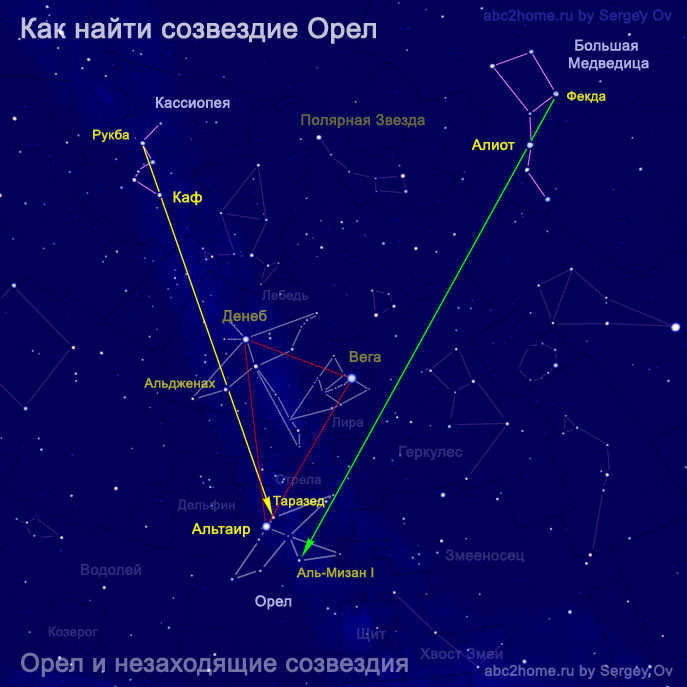
Figure 17.Aql. Discovering the constellation Eagle is possible by locating the constellations Big Dipper and Cassiopeia, which remain visible in Russia.
The most distant sighting of the Eagle constellation stars is the line of sight from the stars of the Big Dipper, specifically Phecda (γ UMa; 2.41 m) to Aliot (ε UMa, 1.76m), reaching the fifth brightest white-yellow star Al-Mizan I (δ Aql, 3.36 m). This trajectory is marked with a green arrow in the diagram, indicating that there are no other bright stars along this path.
Another line of sight can be traced from the “Throne” (W asterism) of the Cassiopeia constellation, starting from Rukba (δ Cas; 2.66 m, white) and leading to Kaf (β Cas; 2.28 m, white-yellow). This line is depicted as a yellow arrow in Figure 17. It ultimately leads to the second brightest star of the Eagle constellation, Tarazed (γ Aql, 2.72 m, orange). However, it is important to be careful not to mistake Algenach (ε Cyg; 2.46 m) of the Swan constellation for Tarazed, as Algenach is also orange. Only by continuing along this trajectory will one reach Tarazed in the constellation of Orla.
An expansion of the possibilities for locating the stars of Eagle: A guide to locating the constellation of Eagle
To locate the constellation Sagittarius, you must first be able to locate the constellations of Ursa Minor and Lyra, or the asterism known as the Summer Triangle
A guide to finding the constellation Sagittarius
A zodiacal constellation [4]
Condensed version
The constellation Sagittarius is not prominently visible above the horizon at mid-latitudes, as only the northern part of the constellation can be seen. The southern part of the sky is where the “arrow” of Sagittarius can be observed, with a declination ranging from -45.5° to -12.03°.
The optimal time to observe and study the constellation Sagittarius is during the months of July to September, when it is visible in the evening sky. Its direct ascension is from 17h 36m to 20h 20m..
1. To easily locate the constellation Sagittarius, one can start from Polaris and follow the path towards Alpha Lyrae – Vega (Fig. 6.Sgr):
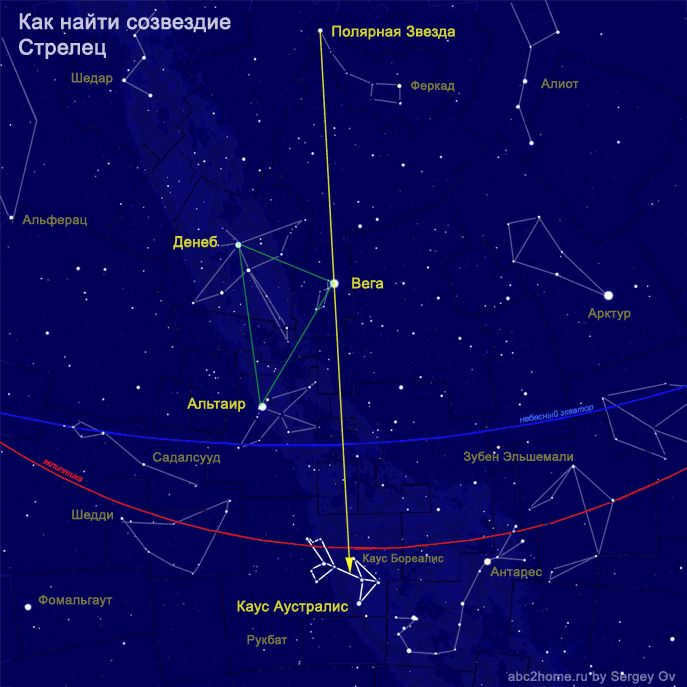
Fig. 6.Sgr. Discovering the constellation Sagittarius in the northern sky
(When using the image, please maintain its original numbering from the article Fig. 6.Sgr – "The constellation Sagittarius", and provide a reference to the original source.)
To locate the constellation Sagittarius, start by drawing a line from Polaris to Lyra and extending it the same distance. This will guide you to the asterism Sagittarius Sagittarius. If the line goes beyond the southeastern horizon, the Arrow will soon rise. If the line extends over the western part of the sky, you’ll need to begin observing early the following day to see the constellation Sagittarius.
To find Sagittarius, it’s essential to locate the Great Ark in the western sky.
To locate the constellation of Magus, all you need to do is locate the prominent asterism known as the Big Bucket within the larger constellation of the Big Dipper
Locating the constellation of Volopassus
The Big Dipper constellation [1]
Concise instructions
Every night, if the weather permits, you can observe the constellation of Volopassus in Moscow. Interestingly, modern stargazing guides do not typically mention the Volopassus constellation. However, it is not necessary to search for it, as the handle of the Big Dipper directly points to Volopassus. On the other hand, everyone is taught to search for the brightest star, Actur, using a specific scheme illustrated in Figure 2. The instructions involve following an arc and eventually finding Spica and Arcturus. It’s reminiscent of the lyrics from “The Hare Song.” However, the guides fail to specify the exact location of the center of the circle for that arc.
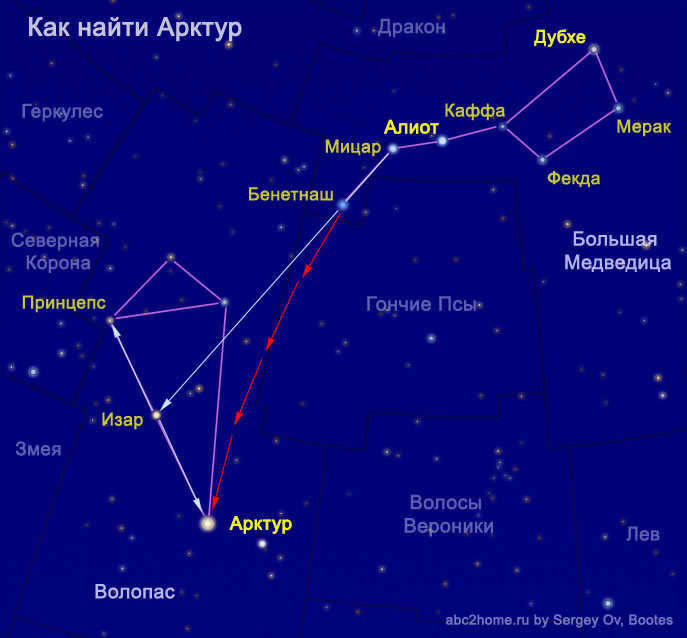

Figure 2. How can one find Arcturus by utilizing the stars of the Big Dipper?
I am unable to mentally draw arcs on the starry sky, so my first step is to mentally draw a line through Mizar and Benetnash (indicated by the light blue arrow in Fig.2).
If the visibility of the starry sky is good, this line will precisely intersect with the second brightest star of Volopassus – Izar. Equidistant from Izar, there will be: to the left of the line – the brightest star Arcturus, and to the right – the faint star Princesa.
In the event that Izar cannot be seen along the line (due to haze or city sky light), it is necessary to draw a line to Arcturus slightly to the left of the original line, gradually moving to the left (indicated by the red arrows in Fig.2, which represent four lengths of the handle of the Big Bucket).This technique is most effective when all the stars of the constellation are visible, as it will consistently guide you to Arcturus without any errors!
To locate the constellation Orion successfully, you must have the ability to locate either the Big Dipper constellation or the Cassiopeia constellation.
How to locate the constellation Orion
The Orion constellation can be observed in the early morning hours at the beginning of autumn in Moscow. To locate the Orion constellation, you can also refer to the figure 8.Ori:
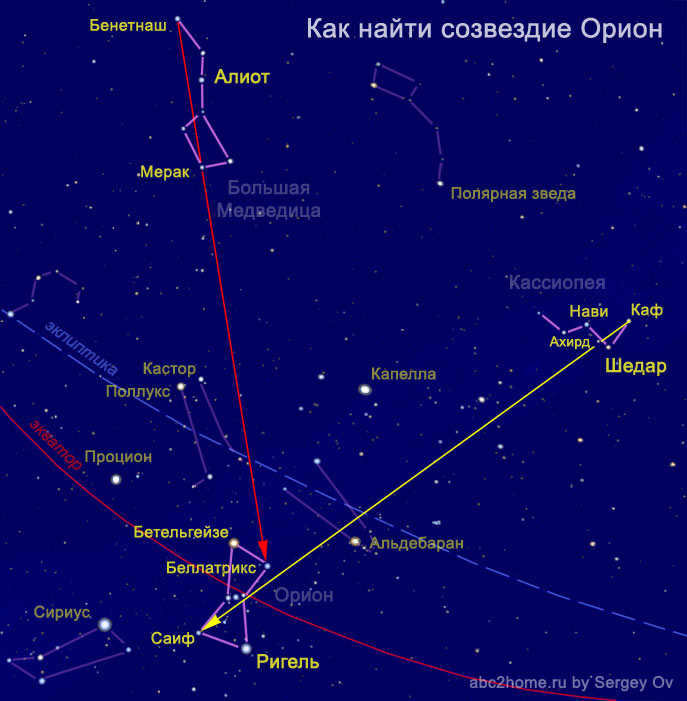
Fig. 8.Ori. How can we locate the constellation Orion using the stars of the Big Dipper and Cassiopeia?
To find the star of Orion’s left shoulder, we can visualize a line passing through Benetnash and Merak, which are the stars of the Big Dipper. This line will lead us to Bellatrix.
The line Kaf – Ahird will first approach Aldebaran, then Orion’s belt, and finally guide us to Saif, which is located at the feet of the hunter.
(When reproducing the figure, please maintain its original numbering as Figure 8.Ori – “Orion constellation,” and provide a link to the original source.)
A comprehensive guide on various methods to locate the stars of Orion: How to find the constellation Orion
In order to locate the constellation Virgo, one must first be able to locate the constellations of Ursa Minor and Ursa Major.
How to Find the Constellation Virgo
A Zodiacal Constellation
Shortened Version
In order to find the constellation Virgo, the first step is to locate its brightest star, Spica.
The simplest method is to use the stars of neighboring constellations to find Alpha Virgo, although it is important to note that these stars may not always be fully visible.
1. The most common approach to finding the constellation Virgo is to start from the north and use Ursa Minor and Ursa Major:
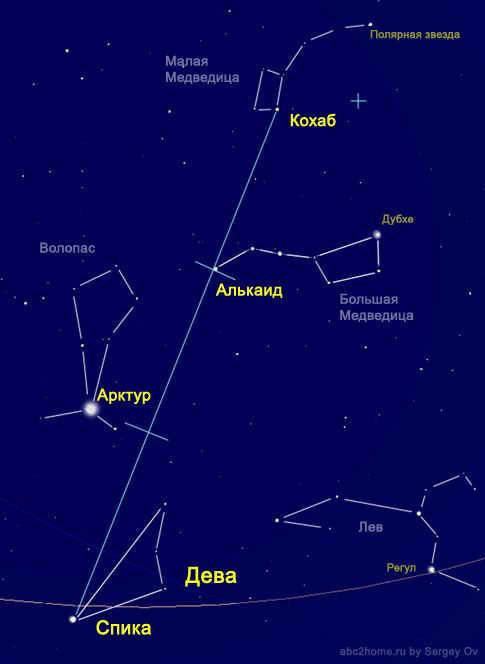
Fig. 2 How to locate the constellation Virgo in the northern part of the sky
2. If you are familiar with the constellation Volopassus, it is worth noting that the asterism Parachute is positioned in such a way that it will move directly towards Spica in its intended “landing” – this is the simplest method to find the constellation Virgo.
An expansion of the choices for locating Virgo stars: How to find the constellation Virgo
To locate the constellation Aries, you must be able to locate the constellation Cassiopeia
Guide to Locating the Aries Constellation
Zodiacal constellation [4]
Abbreviated version
The Aries constellation can be observed in full or in part from June to March in Moscow. For a detailed observation of Aries, the best time is from September to February.
Unfortunately, none of the lines passing through the bright stars of Cassiopeia directly lead to the brightest stars of Aries (Fig.11). However, there is one line that passes through Cas (β Cas; 2.27 m ) and Shedar (α Cas; 2.24 m ), and goes through the star Alamak (γ1 And; 2.1 m ) of the Andromeda constellation which leads to the third brightest star of Aries – Bharani (41 Ari; 3.61 m ).
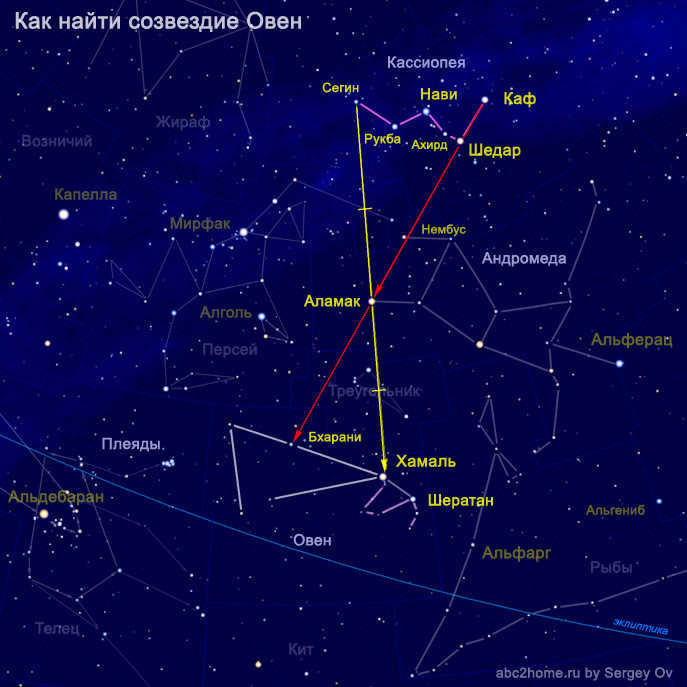
Figure 2. Discovering the constellation Aries using the stars Cassiopeia and Andromeda
The most crucial line in Figure 2 is the red line that passes through the stars Cas (β Cas) and Shedar (α Cas) of the Cassiopeia constellation.
However, following this line directly towards the stars of Aries is not possible. Firstly, in the neighboring Andromeda constellation, this line will nearly intersect with the faint but noticeable star Nembus (51 And; 3.51 m ), and then it will precisely hit Alamac (γ1 And). Only if we continue the yellow line for a similar distance, will we reach the equally bright but bluish star to Nembus, called Bharani (41 Ari).
An explanation of the methods for locating the stars of Aries: Tips on locating the constellation Aries
In order to successfully locate the Taurus constellation, you must first be able to locate either the Big Dipper and Little Dipper constellations or the Orion constellation
Locating the Taurus constellation
Zodiacal constellation [4]
Condensed version
The Taurus constellation can be fully or partially observed in the latitudes of Central Russia from July to April. The optimal time for a detailed observation of the Taurus constellation is between October and February, inclusive.
The Taurus constellation is easily identifiable with the help of the Pleiades, Geyades, and the Orion constellation.
Indeed, when initially exploring the Taurus constellation, it is recommended to start by locating the familiar constellations of the Little and Big Dipper. These constellations are always visible in our night sky, allowing you to determine the positioning of Taurus in relation to the horizon (Fig.14.Tau.):
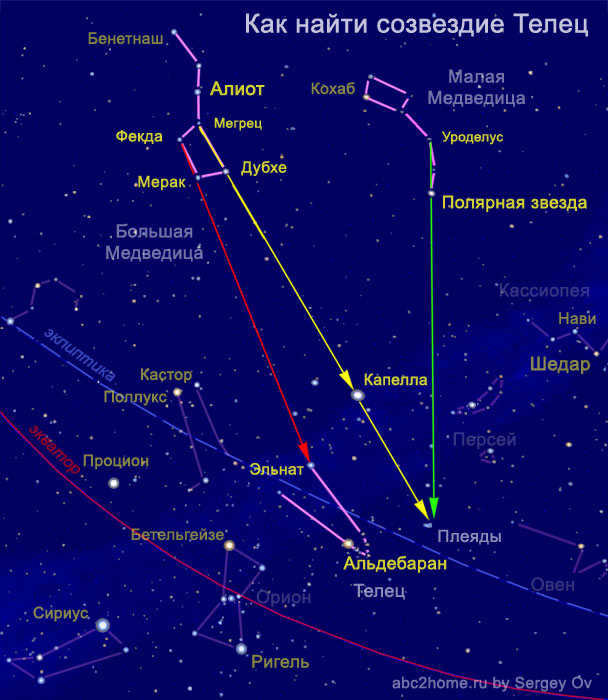
Fig. 14.Tau. Discovering the constellation Taurus by using the constellations of the Minor and Major Dippers
(When utilizing the image, please maintain its original numbering from the initial article Fig.14.Tau – "Constellation Taurus", attribution to the original source is obligatory).
If you extend the line mentally from Megretz (δ Uma) – Dubhe (α Uma) beyond the Big Dipper constellation, it will lead you to the brightest star Capella (Alpha Ascendant) at the edge of the Milky Way. If you continue beyond the Milky Way, you will hit the star cluster of the Pleiades (indicated by yellow arrows). Another way to hit the Pleiades cluster is to follow the green-colored ray from the handle of the Little Bear, starting from Urodelus (ε UMi) and ending at Polaris (α UMi).
A third accurate shot can be obtained by drawing a line from Fekda (γ UMa) to Merak (β UMa) and following it all the way to the Milky Way. The arrow will hit the star Elnath (indicated by a red arrow).
1. The group of constellations that belong to the Big Dipper includes:
Dragon, the Small Dipper, Northern Crown, Wolopassus, Giraffe, Lynx, Little Lion, Hound Dogs, Veronica’s Hair, and, of course, Big Dipper.
Altogether, there are 10 constellations!
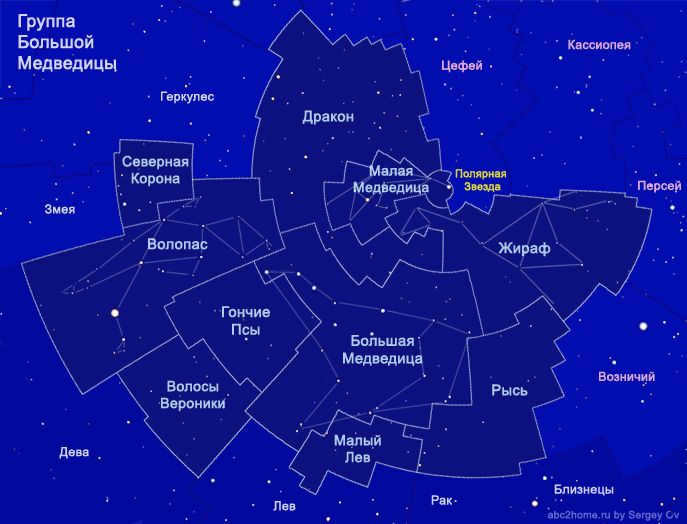
Fig. 16. Uma. Group of constellations from the Big Dipper family (Ursa Major family, Big Dipper family).
By the way, if you observe attentively, the external outlines of the constellation group of the Big Dipper resemble Carlson in the shape of a Little Ghost with a motor.
2. The Perseus group comprises the constellations:
Whale, Pegasus, Andromeda, Ascendant, Perseus, Cassiopeia, Cepheus, Lizard, and Triangle.
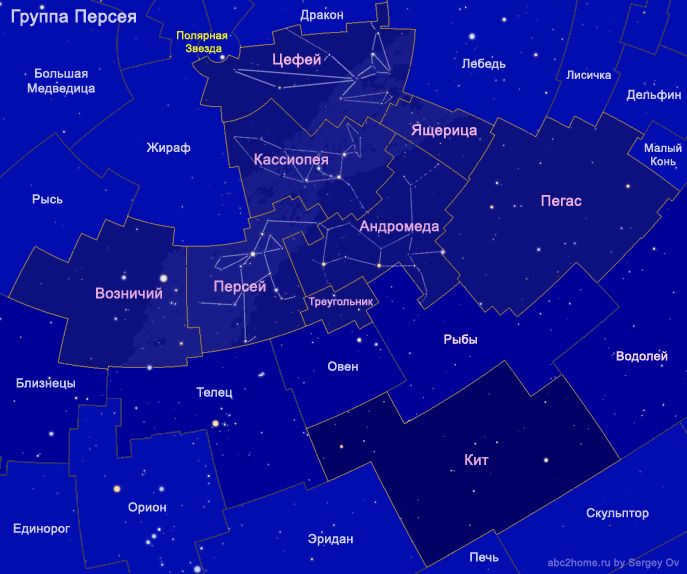
Figure 16.Per. The constellation group of Perseus
The constellations Kit (Cetus), Pegasus, Andromeda, Perseus, Andromeda, and Cepheus are brought together by a shared mythical theme, and the constellations of Ascendant, Lizard, and Triangle, so to speak, have been included in this group due to their common boundaries (or simply because there is no other suitable place for them.).
3. The constellations Swan, Lyra, Hercules, Fox, Arrow, Eagle, Shield, Serpent, and Serpentine are considered part of the Hercules group.
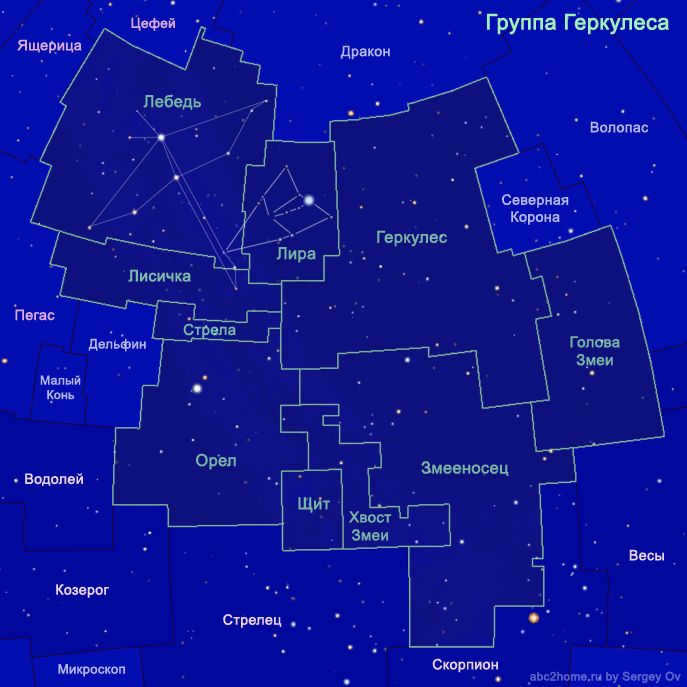
Figure 16.Her. The constellation group of Hercules
4. The zodiacal group consists of the constellations from which the zodiac signs are named, except for Libra, which was actually created based on the zodiac sign, mainly using the stars from the Scorpio constellation. The zodiacal constellation group includes the following constellations: Leo, Virgo, Libra, Scorpio, Sagittarius, Capricorn, Aquarius, Pisces, Aries, Taurus, Gemini, Cancer.
5. The Orion’s group comprises the constellations: Big Dog, Hare, Unicorn, Little Dog, and of course, Orion. In total, there are 5 constellations.
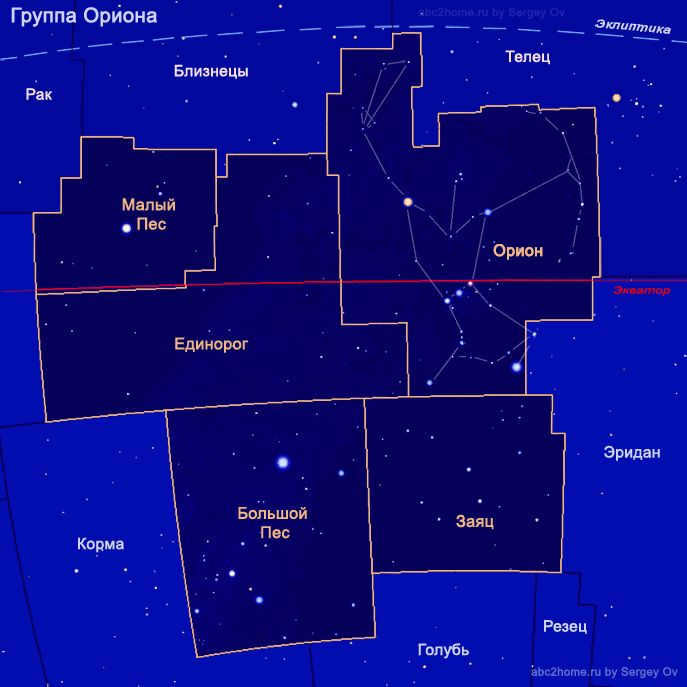
Figure 16. Ori. Collection of constellations belonging to the Orion family
By the way, if we carefully examine the text of the “Myth-Legend of Orion”, we can see that the constellation group of Orion should also include Eridanus, as it is closely related to the story and origins of Orion.
Back in the day, in order to make it easier to navigate among the stars, people divided the entire sky into constellations. Initially, only the parts of the sky visible from Europe were taken into account, but with the Age of Discovery, the southern sky was also included. Nowadays, there are a total of 88 constellations in the night sky. However, astronomers felt that this was not sufficient and decided to add asterisms to the constellations. One such example is the Summer-Autumn Triangle, which is a prominent formation in the summer and fall skies. Although it is not considered a constellation, it is an asterism that is formed by the bright stars of three different constellations.
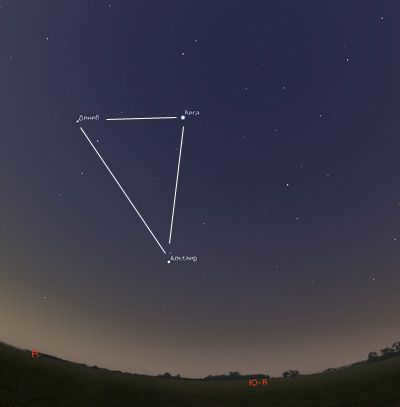
The emergence of the Summer-Fall Triangle in the June sky. Illustration: Stellarium
The Summer-Fall Triangle is the primary star pattern worth familiarizing oneself with in the summer night sky and the evening fall sky. Why? Because it is immense and luminous! It immediately catches your attention, as soon as you direct your gaze towards the sky! (For instance, at the latitude of St. Petersburg and Vologda, it is practically the sole pattern visible during the white nights). And because it is so extensive and prominent, it can be utilized in numerous ways, primarily for locating constellations, stars, and planets.
Do not be confused by the titles!
Important: the sky is abundant with triangles. Take any three stars, mentally connect them with lines, and voila, you have a triangle. You can even give it your own unique name, like Tiny Triangle or Triangle of Faint Stars, and then utilize it for your own convenience. However, in addition to these casual triangles, whose existence is unknown to anyone, there are also well-established entities. For instance, the constellations of the Triangle and the Southern Triangle are officially recognized entities in the celestial realm. Asterisms are a bit more complex – they are acknowledged by the astronomical community, but unofficially. For instance, the Big Bucket is still considered part of the Big Dipper constellation, and nothing more. The same applies to the summer and fall triangle.
Because asterisms are unofficial stellar patterns, they often lack designated names, despite being widely recognized. For instance, the Summer-Autumn Triangle is commonly known as the Summer Triangle or even The Great Summer Triangle. (Is there a smaller one?) In countries of the north, the term the summer-fall triangle has gained popularity due to its observation in the evening sky until the onset of winter.
How to locate the summer-fall triangle in the celestial sphere?
Despite its prominent size and brilliance, the summer-fall triangle is worth observing in the night sky, as its position varies throughout the year.
During the summer months, following the conclusion of evening twilight, the Summer-Autumn Triangle becomes visible in the southeastern region (during the first half of summer) and later in the southern part of the sky (in August). The two uppermost stars, Vega and Deneb, can be found almost directly overhead, near the zenith, while the third star, Altair, is positioned approximately midway between the zenith and the horizon.
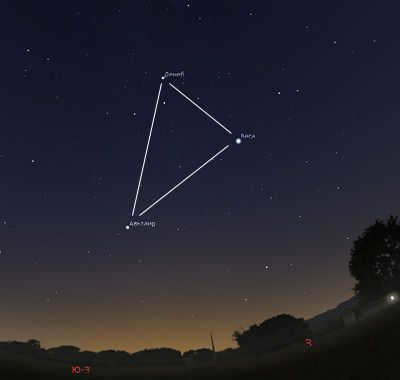
The summer-fall triangle can be seen in the western sky during the evening in December. Image: Stellarium
During the autumn season, the Summer-Autumn Triangle can be observed in the southern sky during the first half of the evening, and in the southwestern sky during the second half.
Even in December, this group of stars can still be seen in the western sky within a few hours after sunset!
Stars that Form the Summer-Autumn Triangle
The Summer-Autumn Triangle is created by three prominent stars – Vega, Deneb, and Altair.
Vega can be found in the upper right corner of the triangle. It is the most brilliant star in the small constellation Lyra and ranks as the fifth brightest star in the entire night sky. With a luminosity of 0.0 m, Vega shines incredibly bright. Moving to the bottom of the triangle, we have Altair leading the constellation Eagle. Altair has a luminosity of 0.76 m, making it the twelfth brightest star in the sky. Lastly, Deneb is situated in the upper left corner of the triangle and is the primary star in the constellation Swan. Deneb’s brilliance measures 1.25 m, securing its place as the nineteenth brightest star in the night sky.
Interestingly, all three stars possess a white hue, indicating that they have a similar surface temperature of approximately 9000°. However, their physical attributes differ. Vega and Altair are located in close proximity to the Sun, with Vega being 25 light-years away and Altair being 16 light-years away. Both stars, like the Sun, are categorized as Main Sequence stars, which means that they undergo the conversion of hydrogen to helium in their cores. In contrast, Deneb is situated approximately 100 times farther away than Vega, yet it exhibits a nearly equivalent level of brightness. As a result, Deneb’s luminosity is approximately 3000 times greater than that of Vega, which itself emits 40 times more light than our Sun. Therefore, Alpha Swan radiates an amount of light equivalent to 120,000 Suns! Spectral examinations have confirmed that Deneb is classified as a supergiant star.
Deneb is perceived as the most brilliant star visible to the naked eye in the night sky.
Using the Summer-Autumn Triangle to Spot Constellations
Let’s now explore the Summer-Autumn Triangle’s main purpose and utilize it to locate various celestial objects in the night sky.
Spotting the Milky Way
Many individuals are curious about how to observe the Milky Way in the night sky. Firstly, it is necessary to distance oneself from urban areas, where the sky is truly dark and filled with stars. Secondly, one must be aware of where to direct their gaze. The most prominent segments of the Milky Way that can be seen in Russia lie within the constellations of Cygnus, Aquila, Scutum, Scorpius, and Sagittarius. Simply put, the Milky Way’s trajectory descends towards the horizon through the Summer-Autumn Triangle along its left side – from Deneb to Altair.

The Summer-Fall Triangle is where the Milky Way can be seen passing through. This can be observed in the sky.
The constellation known as the Swan
One of the most visually stunning constellations present in the sky is the Swan constellation. It can easily be found by utilizing the Summer-Autumn Triangle. The primary star of the Swan, Deneb, is one of the stars that make up this triangle. The journey begins from here.
The star Deneb is located in the tail of the bird, while the beautiful double star Albireo marks its head. The body of the bird is formed by the star Sadr, also known as γ of the Swan. It is closer to Deneb than to Albireo, just like a swan has a long neck! On either side of Sadr, there are two equally bright stars, similar to the stars in the Big Dipper. To the east, you can find the star epsilon of the Swan, or Al Janah. To the west, the star Delta of the Swan can be seen.
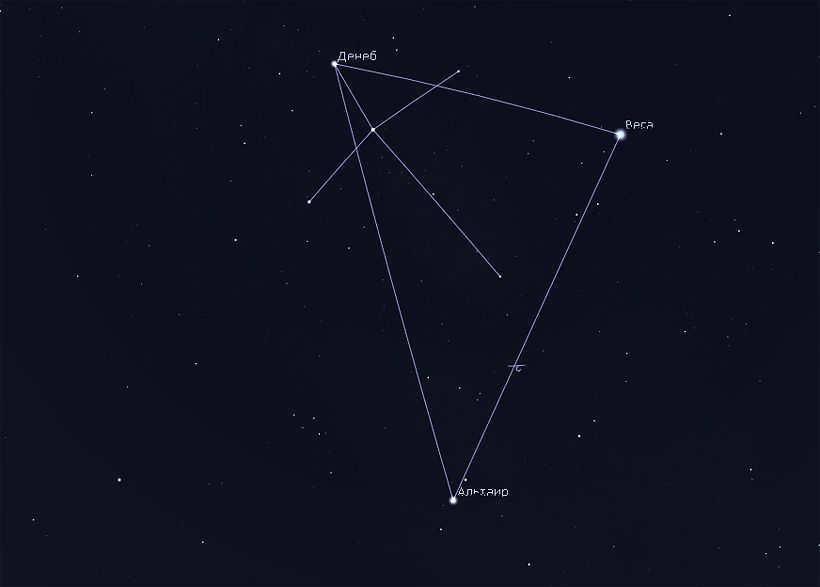
The asterisms known as the Grand Summer Triangle and the Northern Cross can be observed in the night sky. This image, provided by Stellarium, showcases these formations.
The arrangement of five stars mentioned above creates the shape of a cross, which has been historically associated with the crucifixion of Jesus during the Middle Ages. In major cities, the constellation known as the Swan can be seen in the form of this cross.
However, this cross is only a small part of the entire constellation. On dark nights, it is possible to observe additional stars located to the right and left of the crossbar. Once these stars are visible, it becomes apparent that they outline the shape of a massive bird in flight. The outstretched wings of this bird are formed by the stars κ, δ, γ, ε, and ζ of the Swan.
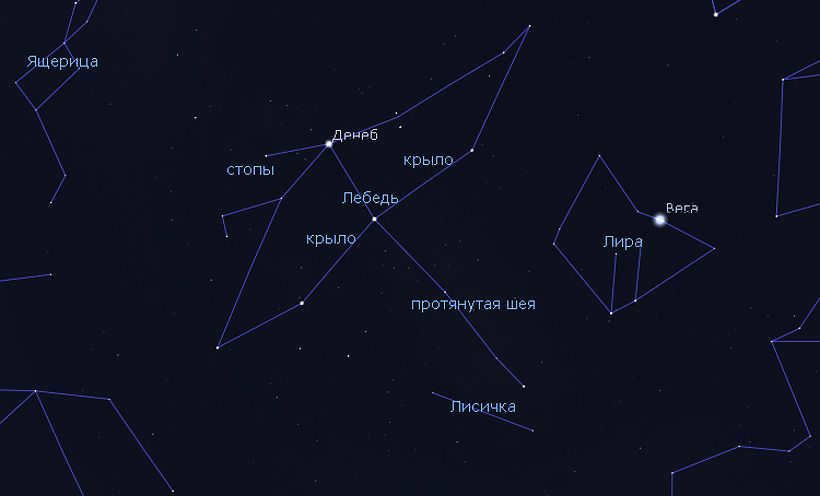
A detailed depiction of the Swan constellation, sourced from G. Ray’s book Stars and presented by Stellarium.
Planning and navigating while traversing the Milky Way becomes evident when observing the majestic outline of a colossal bird within the Swan constellation. Over time, one will acquire the skill to easily locate this constellation.
Similarly, by using the stars of the Summer-Autumn Triangle or the entire figure as a starting point, one can discover numerous other constellations in the sky, such as the Serpent, Eagle, Pegasus, Hercules, Dolphin, Sagittarius, and many more.
Planets and the Summer-Autumn Triangle
Spotting planets in the sky with the help of the Summer-Autumn Triangle is a common practice. As you may already know, the planets follow a path through the constellations of the Zodiac, which together form the zodiacal circle. This circle is inclined with respect to the horizon, resulting in a portion of it being positioned high in the sky while another portion is closer to the horizon (this explains why the Sun appears higher in the summer and lower in the winter!). The southern zodiacal constellations – Serpent, Scorpio, Sagittarius, and Capricorn – which are situated lower in the sky, are conveniently located just below the Summer-Autumn Triangle. Hence, utilizing the Summer-Fall Triangle as a reference point can be highly beneficial when searching for planets.
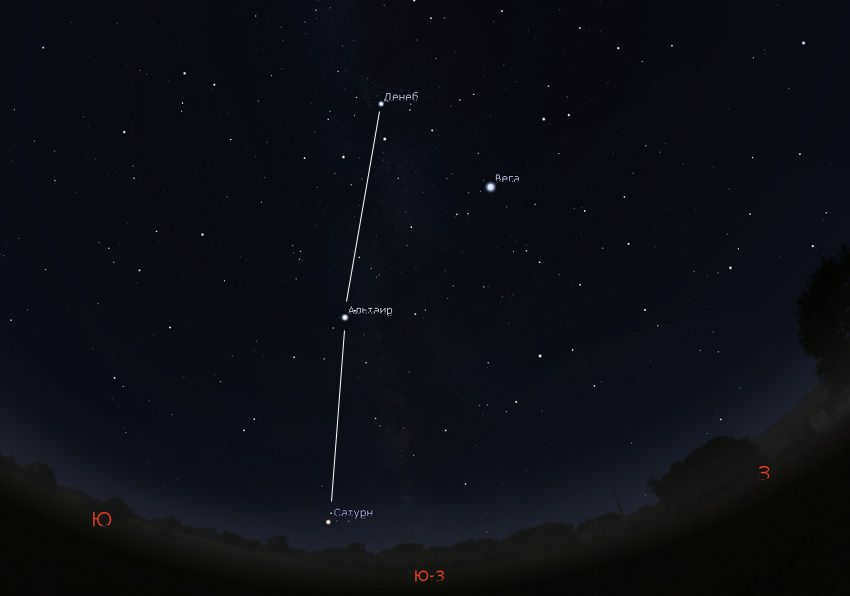
During the years 2019 and 2020, the celestial body known as Saturn can be found within the region of the Summer-Fall Triangle. In the same year of 2020, Jupiter will also be present in this area. This information has been visualized in the diagram provided by Stellarium.
Consequently, during the aforementioned years of 2019 and 2020, the planets Saturn and Jupiter can be observed within the boundaries of the Sagittarius constellation. To successfully locate them, it is as simple as extending the line that connects the stars Deneb and Altair until it reaches the horizon.
The initial statement is that Sagittarius is exclusively a summer constellation. It can be observed in almost the entire territory of Russia from June to August. Its presence in the sky is slightly longer in the southernmost regions of Russia. However, Sagittarius cannot be seen beyond the Arctic Circle.
Therefore, it is advisable to search for this constellation only during the summer season. However, in the first half of summer, many parts of Russia experience short and bright nights, and Sagittarius does not contain any prominent stars. Consequently, the optimal time to search for Sagittarius is at the end of July and in August.
The second point to note is that at the same latitude as St. Petersburg, Minsk, and Moscow, the constellation of Sagittarius does not reach its highest point in the sky. This is significant because it is easier to remember the main pattern of Sagittarius when it is fully visible.
Lastly, a third point to consider is that Sagittarius is a zodiacal constellation. This means that the path of the Sun and the planets passes through this constellation. This can sometimes cause confusion for novice stargazers, as bright planets may appear as “extra stars” within the drawing of Sagittarius. For example, in 2019, the planet Saturn was in Sagittarius, and in 2020, both Saturn and Jupiter are present in this constellation!
Regarding the Sun, it remains in Sagittarius from mid-December to mid-January.
What is the appearance of Sagittarius constellation in the night sky?
There are only a few constellations in the celestial sphere that possess a distinctive and unforgettable configuration. Sagittarius happens to be one of those constellations. However, the arrangement of its most luminous stars does not bear any resemblance to a human figure with a bow. Instead, it bears a striking resemblance to… a regular tea kettle!
Asterism Kettle
The Asterism Kettle is a unique and innovative kitchen appliance that is designed to make your tea and coffee brewing experience more enjoyable and convenient. This kettle features a sleek and modern design with a built-in LCD display and touch controls, allowing you to easily adjust the temperature and brewing time. The Asterism Kettle also has a smart sensor that automatically turns off the kettle when it detects that the water has reached the desired temperature. With its advanced features and stylish design, the Asterism Kettle is a must-have for any tea or coffee lover.

In the sky of Sochi, we can observe the constellation of Sagittarius (the boundaries of the constellation are indicated by a red line). It is interesting to note that even in the southern region of Russia, Sagittarius does not fully rise. The image provided is from Stellarium.
Let’s take a closer look at the diagram illustrating the position of Sagittarius as it crosses the meridian in the skies of Crimea and Sochi. It doesn’t require much imagination to recognize not only the shape of a liquid container formed by the stars, but also the spout, handle, and even the lid!

Only the spout and, partially, the lid of the asterism “Kettle” in the St. Petersburg sky are visible. Image: Stellarium
Therefore, the main figure of Sagittarius is the asterism “Kettle”. However, in Moscow, at the latitude of Moscow, the “Kettle” does not rise completely. Only the spout and lid are visible above the horizon, and the tea container and handle are partially visible (the star epsilon Sagittarius does not rise above the horizon).
At the latitude of St. Petersburg, the situation is even worse, as the handle is not visible at all.
This is why it is not easy for most of us to find the constellation of Sagittarius in the sky!
Or perhaps it’s actually an archer?
During his era, Hans Rey, an American writer, aimed to identify the symbolic figures represented by constellations. The outcome of his efforts was an exceptional book titled “Stars: New outlines of old constellations”, which has been translated into various languages, including Russian.
According to Rey, it is possible to perceive the shape of a man holding a bow within the Sagittarius constellation. Observe how he connected the stars within this constellation:
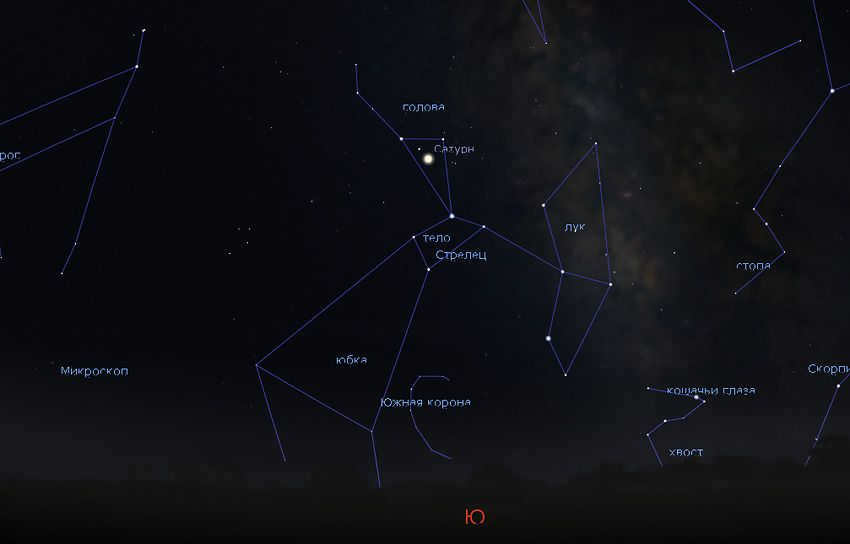

G. Ray’s depiction of Sagittarius constellation. Image source: Stellarium
It’s worth mentioning that in Russia, the legs of the archer are not visible, giving the figure an appearance of disproportion.
How to locate the Sagittarius constellation?
If you want to spot the Sagittarius constellation, simply direct your gaze towards the southern sky during the evening hours, specifically in the latter part of summer, once darkness has fallen. You will find this celestial formation positioned directly below the Summer Triangle.
In the southern regions of Russia, the Sagittarius constellation ascends from the southeast and descends beyond the horizon towards the southwest. However, in the Crimea and the Caucasus, one can witness Sagittarius from April onwards (rising in the morning) all the way until October (when it becomes visible in the early evening).

In August, the Sagittarius constellation can be observed in the Moscow sky. The image was captured by Stellarium.
Exploring the Sagittarius Constellation and the Milky Way

The Sagittarius constellation is particularly fascinating because it serves as a pathway for the Milky Way. Additionally, within this constellation, you can find the most luminous sections of the Milky Way in the celestial sphere! It’s no surprise, considering that Sagittarius is positioned in the heart of our galaxy, where stars are densely clustered. This configuration creates a spherical bulge that significantly widens the appearance of the Milky Way in the sky, encompassing the nearby constellations of Scorpius and Serpens.
It’s unfortunate that the central region of the Galaxy is obscured from our view by clouds of dark interstellar dust! If not for these obstructions, the Milky Way in Sagittarius would shine even brighter than a full Moon in the sky – its radiance would be sufficient to read a book on the darkest night!
However, despite its shortened state, the Sagittarius region of the Milky Way is a veritable treasure trove of stunning nebulae and clusters of stars. In the southern part of Russia, even with a modest amateur telescope, one can marvel at the brilliance of the M8 nebula (commonly known as the “Lagoon”), the M20 nebula (often referred to as the “Triple” or “Trifid”), and the M17 nebula (affectionately called the “Omega”). The brightness of the M22 globular cluster rivals that of the renowned M13 in Hercules. Additionally, the M25 star cluster and the M24 star cloud, both visible to the naked eye, are truly awe-inspiring when observed through a telescope or, better yet, high-quality astronomical binoculars!
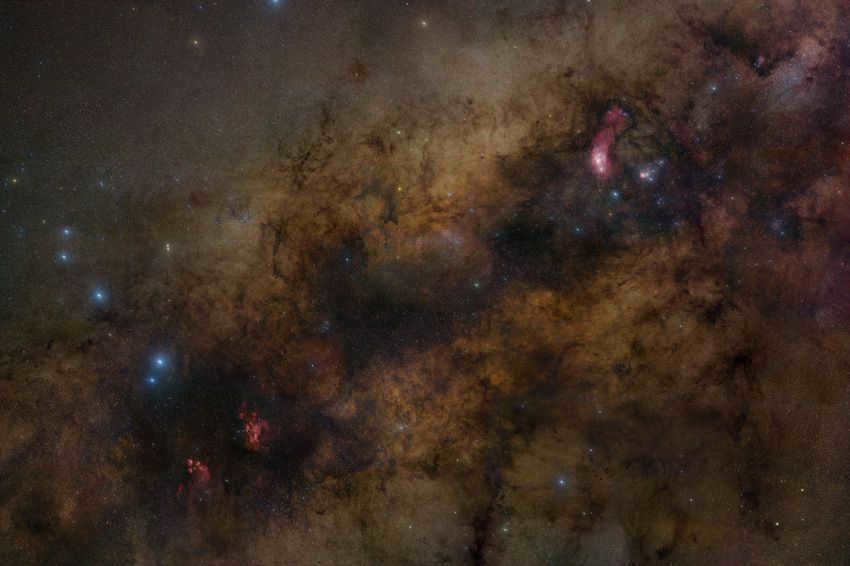
The core of the Galaxy. This compilation of the Milky Way in Sagittarius showcases approximately 30 entities from the Messier catalog: glowing red hydrogen nebulae, spread out and spherical star clusters. Image: Robert Gendler (robgendlerastropics.com)/APOD
During the months of July and August, stargazers are treated to exceptional views of the Sagittarius constellation. With its easy visibility and a plethora of captivating celestial phenomena, Sagittarius presents itself as an excellent subject of exploration for both professional and amateur astronomers alike.
Given its appearance, the Sagittarius constellation is often likened to a teapot. The main square shape represents the teapot’s body, while the handle and spout extend outward from it. Some observers even suggest that the Milky Way appears to emanate from the spout like vapor.
Exploring the Sagittarius Constellation
During the months of July, August, and early September, Sagittarius, a constellation in the northern hemisphere, can be observed at its highest point in the southern sky. For those located south of the equator, Sagittarius is also visible in the northern sky.
Sagittarius stands out in the night sky due to its unique shape, resembling a teapot. It can be easily spotted next to the curved body of Scorpius, also known as Scorpio. These constellations not only offer a breathtaking view of celestial bodies but also straddle the core of our galaxy, home to the black hole Sgr A*.
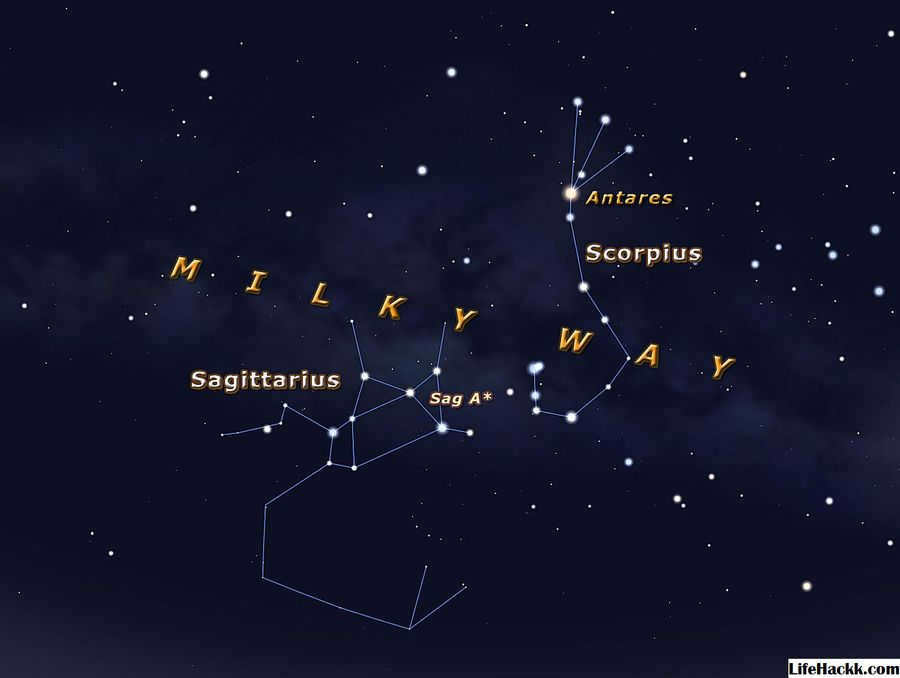
Everything you need to know about Scorpius
Scorpius is widely recognized as a celestial representation of an archer, although the ancient Greeks perceived it as a stellar embodiment of a mythical creature known as a centaur.
Moreover, certain mythologies associate Scorpius with Pan, the deity who invented archery. His name was Krotus, and Zeus, the king of the gods, placed him in the heavens for all to witness the art of archery. (Nevertheless, most observers do not perceive an archer when they gaze upon Scorpius – the shape of a teapot is much more easily discernible.)
Stars in the Scorpius Constellation
Kaus Australis, also known as Epsilon Sagittarius, is the most radiant star in the Scorpius constellation. The second most brilliant star is Nunki, also referred to as Sigma Sagittarius. Nunki, or Sigma, was one of the guiding stars used by the Voyager 2 spacecraft during its journey to the outer regions of the solar system to investigate the gas giant planets.
The main constellation of Scorpius is comprised of eight prominent stars that form a distinctive “kettle” shape. According to the International Astronomical Union (IAU), the remaining part of the constellation contains several dozen additional stars.
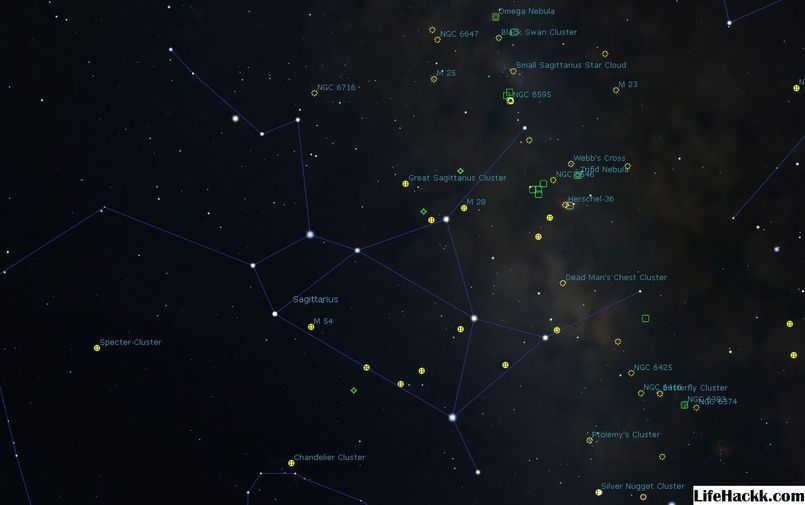
Top Picks for Deep Sky Objects in the Sagittarius Constellation
Sagittarius is positioned directly on the plane of the Milky Way, with its teapot spout almost perfectly aligned towards the center of our galaxy. This unique placement allows for a rich abundance of celestial wonders to be observed in this part of the sky, particularly in the form of star clusters. Among these clusters, both globular and open, stargazers can marvel at the vastness and diversity of the cosmos. Globular clusters consist of stars arranged in a spherical shape, with many of these clusters predating the birth of our galaxy. On the other hand, open star clusters are characterized by a looser gravitational bond compared to globules.
Adding to the splendor of Sagittarius are its stunning nebulae, which are regions of gas and dust that are illuminated by the radiation emitted by neighboring stars. Within this constellation, there are several noteworthy nebulae that are worth exploring. These include the captivating Lagoon Nebula, the mesmerizing Three Dimensional Nebula, as well as the globular clusters M22 and M55. By directing our gaze towards these celestial marvels, we can gain a deeper understanding of the vastness and beauty of the universe.
Nebulae in Sagittarius
Due to our unique vantage point within the galaxy, it is quite common to observe vast clouds of gas and dust in the plane of the Milky Way. This phenomenon is particularly prominent in the Sagittarius region. The Lagoon and Trifid Nebulae can be easily identified, although they are only clearly visible through the use of binoculars or a small telescope. Within these nebulae, astronomers have discovered active star formation, with the presence of both newly formed stars and protostellar objects. This provides valuable insight into the process of star birth.
The Trifid nebula, also referred to as Messier 20, has been the subject of research by numerous terrestrial observatories and the Hubble Space Telescope. While it may appear somewhat faint, it is readily observable with a modest telescope. Its moniker is derived from its resemblance to a diminutive body of water nestled amidst the radiant regions of the Milky Way. Trifid presents with a tripartite structure, featuring three interconnected lobes. Situated at a distance of slightly over four thousand light-years from our vantage point.
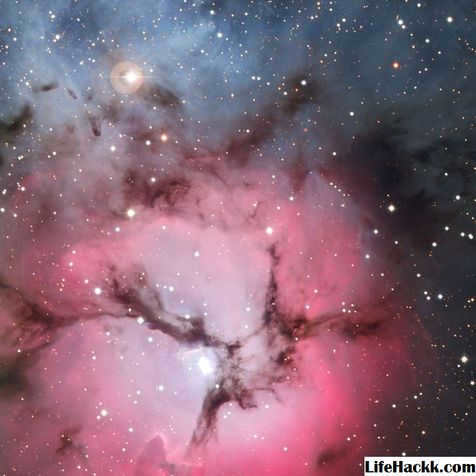
The Presence of Globular Clusters within the Sagittarius Constellation
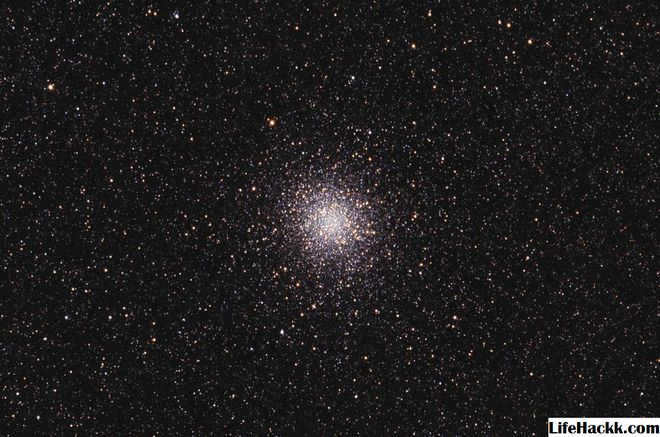
The Milky Way Galaxy has several satellites known as globular clusters. These clusters are made up of hundreds to millions of stars that are gravitationally bound together. One such cluster is M22, which was first discovered in 1665 and contains approximately 300,000 stars. It spans a region of space that is about 50 light-years wide.
Another interesting globular cluster in the Sagittarius constellation is M55, which was discovered in 1752. It consists of just under 300,000 stars and spans an area that is about 48 light-years wide. M55 is located approximately 18,000 light-years away from Earth. To observe Sagittarius and other clusters and nebulae, it is recommended to use binoculars or a small telescope.
The constellation Sagittarius is commonly referred to as a teapot due to its resemblance: the main square form represents the body of a teapot, with the handle and spout extending outward. Some observers even note that the Milky Way appears to emanate from the spout like vapor.
Exploring the constellation Sagittarius
In the northern hemisphere, Sagittarius reaches its highest point in the southern part of the sky during July, August, and early September. For regions south of the equator, Sagittarius is also visible high in the northern part of the sky.
Sagittarius has such a distinct shape that it is easily recognizable in the night sky. Simply look for the teapot shape next to the curved body of Scorpius. These constellations not only contain breathtaking celestial objects to observe, but they also straddle the core of our galaxy, where the black hole Sgr A* resides.

All you need to know about Scorpius
Scorpius is widely recognized as a celestial archer, although the ancient Greeks regarded him as a heavenly embodiment of a mythical creature known as a centaur.
Furthermore, certain myths attribute Scorpius as the offspring of Pan, the god responsible for the creation of archery. His name was Krotus, and Zeus, the supreme deity, placed him in the heavens so that all could marvel at his archery skills. (However, most observers do not perceive an archer when they observe Scorpius – its resemblance to a teapot is much more apparent.)
Stars in the Scorpio Constellation
Kaus Australis, also known as Epsilon Sagittarius, is the most luminous star in the Scorpio constellation. The second brightest star is Nunki, or Sigma Sagittarius. Nunki was one of the stars used by the Voyager 2 spacecraft for navigation during its mission to the outer solar system to study the gas giant planets.
The main constellation of Scorpio is formed by eight prominent stars that resemble a “kettle” shape. In addition to these stars, there are several dozen more stars within the boundaries defined by the International Astronomical Union (IAU).

Top celestial objects in the Sagittarius constellation
Sagittarius is situated directly on the plane of the Milky Way, and its teapot spout points almost precisely towards the center of our galaxy. Due to the high population of stars in this region of the sky, stargazers have the opportunity to observe numerous star clusters, including both globular and open star clusters. Globular clusters consist of spherical-shaped stars, many of which are older than the galaxy itself. Open star clusters, on the other hand, are not as tightly bound gravitationally as globules.
Sagittarius is home to a number of stunning nebulae, which are clusters of gas and dust that are illuminated by nearby stars. Some of the most notable nebulae in this area include the Lagoon Nebula, the Three Dimensional Nebula, and the globular clusters M22 and M55.
Nebulae in Sagittarius
Because we have an internal view of our galaxy, it is common to observe clouds of gas and dust in the plane of the Milky Way. This is particularly evident in Sagittarius. The Lagoon and Trifid Nebulae are easily identifiable, although they are best viewed through binoculars or a small telescope. These nebulae contain areas where new stars are forming, providing astronomers with a unique opportunity to study the process of star birth.
Trifid, also identified as Messier 20, has been extensively examined by various terrestrial observatories and the Hubble Space Telescope. Although it may appear slightly faint, it can be readily observed through a small telescope. Its designation derives from its resemblance to a compact pond adjacent to the luminous regions of the Milky Way. Trifid appears to consist of three interconnected “lobes” and is situated at a distance of slightly over four thousand light years from our location.

Exploring the Sagittarius Constellation’s Globular Clusters


